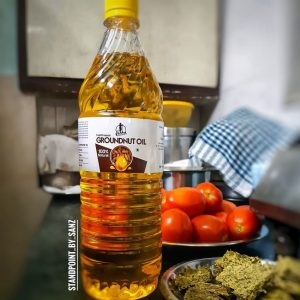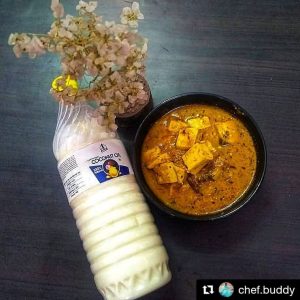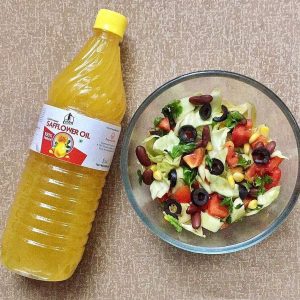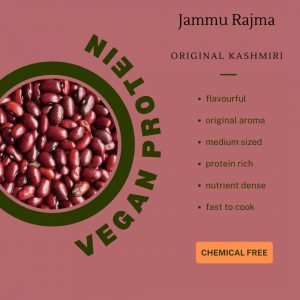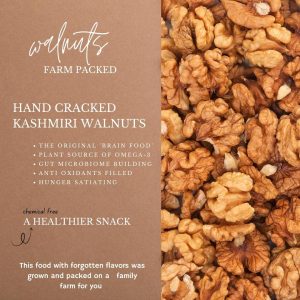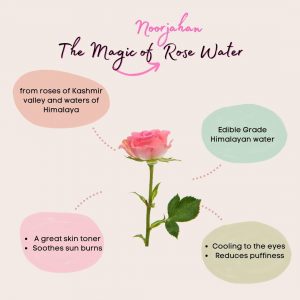Shop
Groundnut Oil
₹ 420.00 – ₹ 1,990.00What are cold pressed oils?
The oils that you use for cooking everything are extracted from seeds, fruits or vegetables and even nuts. Cold pressing is the method of oil extraction from oilseeds which may include sesame seed, sunflower seeds, canola, coconut or olive without really using heat to extract as that may degrade the oil’s flavour and nutritional quality. Cold pressing method is the process involving crushing seeds or nuts and forcing out the oil through pressure.
In olden times, a long cylindrical contraption known as ‘ghani’ was used to extract oil from oilseeds. Ghani was a mortar and pestle device made of stone or wood that used a perambulating animal to extract oil under pressure from oil-bearing seeds. This was the simplest method for cold pressing oils out of a seed as it didn’t involve the generation of too much heat.
What is available at most stores & supermarkets ?
If you are careful enough you will see different kinds of labels on your oil packaging :
“Losorb”
“Lite”
“Blanched”
“Refined”
What these words really mean is “our oil has gone through tons of chemical processes and is stripped of all it’s natural nutrients!”
What is Oil Refining?
Refining is a process of purification of oils. In this process, oils are robbed of naturally occurring gums, proteins, phospholipids, fine seed particles etc. This makes the oil “light/losorb”. Oils are also neutralized (acidity balanced!), bleached (stripped of color) and deodorized (devoid of it’s natural aroma). And to achieve all these the oil is heated at high temperatures and is treated with chemicals etc.
In a nutshell, modern refined cooking oils provide nothing but pure empty calories (devoid of all nutrients but fats!)
Here’s what Oil Refining looks like :
Why do oil companies sell Refined Oils ?
•Yield
•Shelf Life
•Price
•Modern cooking style of “deep frying”
Why you should move to cold pressed oils :
• Nutritionally Rich: Be it traditional lakdi ghana/kachchi ghani/chekku ennai or commercially prepared extra virgin oils (made using temperature controlled expeller pressing method), cold pressed oils retain most of proteins, vitamins, phosholipids, antioxidants, lecithin etc. And obtaining these essential nutrients from an all natural source is a much wiser and holistic choice than getting them from multivitamin pills.
• Chemical Free: During refining, various chemicals are used like Hexane, Sodium Hydroxide, Sodium Bicarbonate (baking soda), Bleaching Agents etc. And on top of that chemicals like Propyl Gallate, BHA, BHT are introduced as preservatives! Now not all of these are exactly toxic or carcinogenic , but if you are someone who is conscious about living organically and staying away from chemicals, you should consider switching back to cold pressed!
• Forgotten Flavors: Virgin oils, their flavor and aroma, compliments all Indian foods and the spices well. Get those forgotten flavors back into your food.
• Environmental Impact: You lower your carbon foot-print when you are consuming less processed things and saving the environment too.
• Way of Life: Cooking with cold pressed oils has been a tradition not only in India.
Few things to remember :
• Storage:
Cold pressed oils have a limited shelf life (max 6 months). You can always maximize the shelf life by storing it in the cold (think refrigeration) and dark (think non transparent bottles) places, although it is always advisable to use them up as soon as possible to reap their full nutritional benefits.
• Using it up :
Every time you open a bottle of any cold pressed cooking oil – use within 45days.
Sesame oil (white)
₹ 450.00 – ₹ 2,200.00What are cold pressed oils?
The oils that you use for cooking everything are extracted from seeds, fruits or vegetables and even nuts. Cold pressing is the method of oil extraction from oilseeds which may include sesame seed, sunflower seeds, canola, coconut or olive without really using heat to extract as that may degrade the oil’s flavour and nutritional quality. Cold pressing method is the process involving crushing seeds or nuts and forcing out the oil through pressure.
In olden times, a long cylindrical contraption known as ‘ghani’ was used to extract oil from oilseeds. Ghani was a mortar and pestle device made of stone or wood that used a perambulating animal to extract oil under pressure from oil-bearing seeds. This was the simplest method for cold pressing oils out of a seed as it didn’t involve the generation of too much heat.
What is available at most stores & supermarkets ?
If you are careful enough you will see different kinds of labels on your oil packaging :
“Losorb”
“Lite”
“Blanched”
“Refined”
What these words really mean is “our oil has gone through tons of chemical processes and is stripped of all it’s natural nutrients!”
What is Oil Refining?
Refining is a process of purification of oils. In this process, oils are robbed of naturally occurring gums, proteins, phospholipids, fine seed particles etc. This makes the oil “light/losorb”. Oils are also neutralized (acidity balanced!), bleached (stripped of color) and deodorized (devoid of it’s natural aroma). And to achieve all these the oil is heated at high temperatures and is treated with chemicals etc.
In a nutshell, modern refined cooking oils provide nothing but pure empty calories (devoid of all nutrients but fats!)
Here’s what Oil Refining looks like :
Why do oil companies sell Refined Oils ?
•Yield
•Shelf Life
•Price
•Modern cooking style of “deep frying”
Why you should move to cold pressed oils :
• Nutritionally Rich: Be it traditional lakdi ghana/kachchi ghani/chekku ennai or commercially prepared extra virgin oils (made using temperature controlled expeller pressing method), cold pressed oils retain most of proteins, vitamins, phosholipids, antioxidants, lecithin etc. And obtaining these essential nutrients from an all natural source is a much wiser and holistic choice than getting them from multivitamin pills.
• Chemical Free: During refining, various chemicals are used like Hexane, Sodium Hydroxide, Sodium Bicarbonate (baking soda), Bleaching Agents etc. And on top of that chemicals like Propyl Gallate, BHA, BHT are introduced as preservatives! Now not all of these are exactly toxic or carcinogenic , but if you are someone who is conscious about living organically and staying away from chemicals, you should consider switching back to cold pressed!
• Forgotten Flavors: Virgin oils, their flavor and aroma, compliments all Indian foods and the spices well. Get those forgotten flavors back into your food.
• Environmental Impact: You lower your carbon foot-print when you are consuming less processed things and saving the environment too.
• Way of Life: Cooking with cold pressed oils has been a tradition not only in India.
Few things to remember :
• Storage:
Cold pressed oils have a limited shelf life (max 6 months). You can always maximize the shelf life by storing it in the cold (think refrigeration) and dark (think non transparent bottles) places, although it is always advisable to use them up as soon as possible to reap their full nutritional benefits.
• Using it up :
Every time you open a bottle of any cold pressed cooking oil – use within 45days.
Mustard Oil
₹ 375.00 – ₹ 1,800.00What are cold pressed oils?
The oils that you use for cooking everything are extracted from seeds, fruits or vegetables and even nuts. Cold pressing is the method of oil extraction from oilseeds which may include sesame seed, sunflower seeds, canola, coconut or olive without really using heat to extract as that may degrade the oil’s flavour and nutritional quality. Cold pressing method is the process involving crushing seeds or nuts and forcing out the oil through pressure.
In olden times, a long cylindrical contraption known as ‘ghani’ was used to extract oil from oilseeds. Ghani was a mortar and pestle device made of stone or wood that used a perambulating animal to extract oil under pressure from oil-bearing seeds. This was the simplest method for cold pressing oils out of a seed as it didn’t involve the generation of too much heat.
What is available at most stores & supermarkets ?
If you are careful enough you will see different kinds of labels on your oil packaging :
“Losorb”
“Lite”
“Blanched”
“Refined”
What these words really mean is “our oil has gone through tons of chemical processes and is stripped of all it’s natural nutrients!”
What is Oil Refining?
Refining is a process of purification of oils. In this process, oils are robbed of naturally occurring gums, proteins, phospholipids, fine seed particles etc. This makes the oil “light/losorb”. Oils are also neutralized (acidity balanced!), bleached (stripped of color) and deodorized (devoid of it’s natural aroma). And to achieve all these the oil is heated at high temperatures and is treated with chemicals etc.
In a nutshell, modern refined cooking oils provide nothing but pure empty calories (devoid of all nutrients but fats!)
Here’s what Oil Refining looks like :
Why do oil companies sell Refined Oils ?
•Yield
•Shelf Life
•Price
•Modern cooking style of “deep frying”
Why you should move to cold pressed oils :
• Nutritionally Rich: Be it traditional lakdi ghana/kachchi ghani/chekku ennai or commercially prepared extra virgin oils (made using temperature controlled expeller pressing method), cold pressed oils retain most of proteins, vitamins, phosholipids, antioxidants, lecithin etc. And obtaining these essential nutrients from an all natural source is a much wiser and holistic choice than getting them from multivitamin pills.
• Chemical Free: During refining, various chemicals are used like Hexane, Sodium Hydroxide, Sodium Bicarbonate (baking soda), Bleaching Agents etc. And on top of that chemicals like Propyl Gallate, BHA, BHT are introduced as preservatives! Now not all of these are exactly toxic or carcinogenic , but if you are someone who is conscious about living organically and staying away from chemicals, you should consider switching back to cold pressed!
• Forgotten Flavors: Virgin oils, their flavor and aroma, compliments all Indian foods and the spices well. Get those forgotten flavors back into your food.
• Environmental Impact: You lower your carbon foot-print when you are consuming less processed things and saving the environment too.
• Way of Life: Cooking with cold pressed oils has been a tradition not only in India.
Few things to remember :
• Storage:
Cold pressed oils have a limited shelf life (max 6 months). You can always maximize the shelf life by storing it in the cold (think refrigeration) and dark (think non transparent bottles) places, although it is always advisable to use them up as soon as possible to reap their full nutritional benefits.
• Using it up :
Every time you open a bottle of any cold pressed cooking oil – use within 45days.
Coconut Oil
₹ 450.00What are cold pressed oils?
The oils that you use for cooking everything are extracted from seeds, fruits or vegetables and even nuts. Cold pressing is the method of oil extraction from oilseeds which may include sesame seed, sunflower seeds, canola, coconut or olive without really using heat to extract as that may degrade the oil’s flavour and nutritional quality. Cold pressing method is the process involving crushing seeds or nuts and forcing out the oil through pressure.
In olden times, a long cylindrical contraption known as ‘ghani’ was used to extract oil from oilseeds. Ghani was a mortar and pestle device made of stone or wood that used a perambulating animal to extract oil under pressure from oil-bearing seeds. This was the simplest method for cold pressing oils out of a seed as it didn’t involve the generation of too much heat.
What is available at most stores & supermarkets ?
If you are careful enough you will see different kinds of labels on your oil packaging :
“Losorb”
“Lite”
“Blanched”
“Refined”
What these words really mean is “our oil has gone through tons of chemical processes and is stripped of all it’s natural nutrients!”
What is Oil Refining?
Refining is a process of purification of oils. In this process, oils are robbed of naturally occurring gums, proteins, phospholipids, fine seed particles etc. This makes the oil “light/losorb”. Oils are also neutralized (acidity balanced!), bleached (stripped of color) and deodorized (devoid of it’s natural aroma). And to achieve all these the oil is heated at high temperatures and is treated with chemicals etc.
In a nutshell, modern refined cooking oils provide nothing but pure empty calories (devoid of all nutrients but fats!)
Here’s what Oil Refining looks like :
Why do oil companies sell Refined Oils ?
•Yield
•Shelf Life
•Price
•Modern cooking style of “deep frying”
Why you should move to cold pressed oils :
• Nutritionally Rich: Be it traditional lakdi ghana/kachchi ghani/chekku ennai or commercially prepared extra virgin oils (made using temperature controlled expeller pressing method), cold pressed oils retain most of proteins, vitamins, phosholipids, antioxidants, lecithin etc. And obtaining these essential nutrients from an all natural source is a much wiser and holistic choice than getting them from multivitamin pills.
• Chemical Free: During refining, various chemicals are used like Hexane, Sodium Hydroxide, Sodium Bicarbonate (baking soda), Bleaching Agents etc. And on top of that chemicals like Propyl Gallate, BHA, BHT are introduced as preservatives! Now not all of these are exactly toxic or carcinogenic , but if you are someone who is conscious about living organically and staying away from chemicals, you should consider switching back to cold pressed!
• Forgotten Flavors: Virgin oils, their flavor and aroma, compliments all Indian foods and the spices well. Get those forgotten flavors back into your food.
• Environmental Impact: You lower your carbon foot-print when you are consuming less processed things and saving the environment too.
• Way of Life: Cooking with cold pressed oils has been a tradition not only in India.
Few things to remember :
• Storage:
Cold pressed oils have a limited shelf life (max 6 months). You can always maximize the shelf life by storing it in the cold (think refrigeration) and dark (think non transparent bottles) places, although it is always advisable to use them up as soon as possible to reap their full nutritional benefits.
• Using it up :
Every time you open a bottle of any cold pressed cooking oil – use within 45days.
Jaggery powder
₹ 105.00Our organic jaggery is made by a marginal farmer, without using Fertilizers, Pesticides or Hormones. This jaggery is a rich source of Iron, calcium, magnesium, essential amino acid, minerals and vital vitamins.
Jaggery can be made from numerous sources like date palm, the sap of coconut and more, but jaggery made from sugarcane juice is most preferred by people. Ancient Ayurveda also strongly recommend jaggery as a tasty and healthy alternative to refined sugar.
Jaggery is 30-40% water, 40-60% sucrose, 15-25% inverted sugar, 0.30% calcium, 8.5-10 mg iron, 05/100 mg phosphorus, 0.10/100 mg, protein and 14/100mg vitamin B. Although it has the same calorific value as that of sugar, it is a better substitute for the white refined sugar as it a a genuinely Food which is medicine.
The colour of the jaggery also plays an important role in identifying purity. Ideally the colour of the jaggery should be dark brown. The yellowish colour may indicate chemical treatment.
Benefits of using jaggery :- Generates heat inside the body
- Boosts immunity within the body
- Prevents constipation and enhances the production of digestive enzymes
- Helps in preventing joint pain
- Detoxifies the body
- Rich in iron contents, prevents anemia
- Boosts body metabolism
Gehu khapli (flour)
₹ 185.00Safflower Oil
₹ 475.00What are cold pressed oils?
The oils that you use for cooking everything are extracted from seeds, fruits or vegetables and even nuts. Cold pressing is the method of oil extraction from oilseeds which may include sesame seed, sunflower seeds, canola, coconut or olive without really using heat to extract as that may degrade the oil’s flavour and nutritional quality. Cold pressing method is the process involving crushing seeds or nuts and forcing out the oil through pressure.
In olden times, a long cylindrical contraption known as ‘ghani’ was used to extract oil from oilseeds. Ghani was a mortar and pestle device made of stone or wood that used a perambulating animal to extract oil under pressure from oil-bearing seeds. This was the simplest method for cold pressing oils out of a seed as it didn’t involve the generation of too much heat.
What is available at most stores & supermarkets ?
If you are careful enough you will see different kinds of labels on your oil packaging :
“Losorb”
“Lite”
“Blanched”
“Refined”
What these words really mean is “our oil has gone through tons of chemical processes and is stripped of all it’s natural nutrients!”
What is Oil Refining?
Refining is a process of purification of oils. In this process, oils are robbed of naturally occurring gums, proteins, phospholipids, fine seed particles etc. This makes the oil “light/losorb”. Oils are also neutralized (acidity balanced!), bleached (stripped of color) and deodorized (devoid of it’s natural aroma). And to achieve all these the oil is heated at high temperatures and is treated with chemicals etc.
In a nutshell, modern refined cooking oils provide nothing but pure empty calories (devoid of all nutrients but fats!)
Here’s what Oil Refining looks like :
Why do oil companies sell Refined Oils ?
•Yield
•Shelf Life
•Price
•Modern cooking style of “deep frying”
Why you should move to cold pressed oils :
• Nutritionally Rich: Be it traditional lakdi ghana/kachchi ghani/chekku ennai or commercially prepared extra virgin oils (made using temperature controlled expeller pressing method), cold pressed oils retain most of proteins, vitamins, phosholipids, antioxidants, lecithin etc. And obtaining these essential nutrients from an all natural source is a much wiser and holistic choice than getting them from multivitamin pills.
• Chemical Free: During refining, various chemicals are used like Hexane, Sodium Hydroxide, Sodium Bicarbonate (baking soda), Bleaching Agents etc. And on top of that chemicals like Propyl Gallate, BHA, BHT are introduced as preservatives! Now not all of these are exactly toxic or carcinogenic , but if you are someone who is conscious about living organically and staying away from chemicals, you should consider switching back to cold pressed!
• Forgotten Flavors: Virgin oils, their flavor and aroma, compliments all Indian foods and the spices well. Get those forgotten flavors back into your food.
• Environmental Impact: You lower your carbon foot-print when you are consuming less processed things and saving the environment too.
• Way of Life: Cooking with cold pressed oils has been a tradition not only in India.
Few things to remember :
• Storage:
Cold pressed oils have a limited shelf life (max 6 months). You can always maximize the shelf life by storing it in the cold (think refrigeration) and dark (think non transparent bottles) places, although it is always advisable to use them up as soon as possible to reap their full nutritional benefits.
• Using it up :
Every time you open a bottle of any cold pressed cooking oil – use within 45days.
Himalayan pink salt
₹ 110.00 – ₹ 500.00- High mineral content, all natural, organic
- The darker the color the more minerals that are in the salt
- Contains 84 trace minerals – including Calcium, Magnesium, Potassium, Copper and Iron
- Made without additives
- Clean, fresh taste with no bitterness
- Seasons meats, grilled vegetables, a variety of salads, soups & stews or use when baking
- Naturally enhances flavour of food
- Ideal for cooking, salt rubs and drinks
Turmeric powder
₹ 150.00 – ₹ 275.00Rajma (jammu)
₹ 150.00 – ₹ 250.00- Isoflavones. A class of antioxidants present in high amounts in Rajma, isoflavones are categorized as phytoestrogens due to their similarity to the female sex hormone, estrogen.
- Anthocyanins. This family of colorful antioxidants occurs in the skin of kidney beans. The color of red kidney beans is mainly due to an anthocyanin known as pelargonidin.
- Phytohaemagglutinin. This toxic protein exists in high amounts in raw kidney beans, especially red varieties. It can be eliminated through cooking.
- Phytic acid. Found in all edible seeds, phytic acid (phytate) impairs your absorption of various minerals, such as iron and zinc. It can be reduced by soaking, sprouting, or fermenting the beans.
- Starch blockers. A class of lectins, also known as alpha-amylase inhibitors, starch blockers impair or delay the absorption of carbs from your digestive tract but are inactivated by cooking.
Premium hing (crystals)
₹ 230.00Benefits of using Hing
1. Aid to stomach problems It is most commonly used as a digestive aid apart from cooking, it is considered as one of the best remedies to balance vata dosha. It is also used as a remedy for flatulence, constipation and digestion. It can be taken with butter milk to help cleanse the digestive system. 2.Antimicrobial It is known to be one of the best home remedies for asthma and bronchitis. In many parts of the world like Afganistan, China, Egypt, Saudi Arabia and Malaysia it is taken to relieve symptoms of whooping cough, asthma and ulcer. 3.Anti-coagulant It has the properties to control cholesterol and blood pressure level and fat consumption too. The gum contains a relaxant compound which improves the blood flow and reduces arterial blood pressure, thus having a positive effect on blood pressure and cardiovascular health. It also has phenolic acid, ferulic acid and tannins which regulate the blood sugar level. Other benefits of Hing include remedy for intestinal gas, bloating and cramps during menstrual cycle and mucous discharge.Akhrot (walnut)
₹ 850.00- Rich in antioxidants
- Super plant source of omega-3s
- May decrease inflammation
- Promotes a healthy gut
- Supports weight control
- Helps control diabetes
- May Help Lower Blood Pressure
Badam (almond)
₹ 800.00These are non-GMO, Heirloom, Desi, Organic Almonds from Kashmir and a small percentage of almonds will be bitter. This bitterness is what helps body remove toxins. These almonds have the highest oil content of all almonds variety and when eaten after soaking in water overnight, these Kashmiri almonds work as medicine.
The almond oil we sell is also extracted from these almonds.
Health benefits of eating a handful of almonds :
1. Almonds Deliver a massive amount of Nutrients
Almonds are the edible seeds of Prunus dulcis, more commonly called the almond tree.
They are also used to produce almond milk, oil, butter, flour or paste — also known as marzipan.
Almonds boast an impressive nutrient profile. A 28-gram serving of almonds contains :
- Fiber: 3.5 grams
- Protein: 6 grams
- Fat: 14 grams (9 of which are monounsaturated)
- Vitamin E: 37% of the RDI
- Manganese: 32% of the RDI
- Magnesium: 20% of the RDI
- They also contain a decent amount of copper, vitamin B2 (riboflavin) and phosphorus.
This is all from a small handful, which supplies only 161 calories and 2.5 grams of digestible carbohydrates.
2. Almonds are loaded with Anti-oxidants
Almonds are a fantastic source of antioxidants.
Antioxidants help protect against oxidative stress, which can damage molecules in your cells and contribute to inflammation, ageing and diseases like cancer.
The powerful antioxidants in almonds are largely concentrated in the brown layer of the skin.
For this reason, blanched almonds — those with skin removed — are not the best choice from a health perspective.
A clinical trial in 60 male smokers found that about 3 ounces (84 grams) of almonds per day reduced oxidative stress biomarkers by 23–34% over a four-week period.
These findings support those of another study which found that eating almonds with main meals reduced some markers of oxidative damage.
3. Almonds are High in Vitamin E
Vitamin E is a family of fat-soluble antioxidants.
These antioxidants tend to build up in cell membranes in your body, protecting your cells from oxidative damage.
Almonds are among the world’s best sources of vitamin E, with just 28g providing 37% of the RDI.
Several studies have linked higher vitamin E intake with lower rates of heart disease, cancer and Alzheimer’s disease.
4. Almonds Can Assist With Blood Sugar Control
Nuts are low in carbs but high in healthy fats, protein and fiber.
This makes them a perfect choice for people with diabetes.
Another boon of almonds is their remarkably high amount of magnesium.
Magnesium is a mineral involved in more than 300 bodily processes, including blood sugar control.
The current RDI for magnesium is 310–420 mg. 2 ounces of almonds provide almost half that amount — 150 mg of this important mineral.
Interestingly, 25–38% of people with type 2 diabetes are deficient in magnesium. Correcting this deficiency significantly lowers blood sugar levels and improves insulin function.
People without diabetes also see major reductions in insulin resistance when supplementing with magnesium.
This indicates that high-magnesium foods such as almonds may help prevent metabolic syndrome and type 2 diabetes, both of which are major health problems.
5. Magnesium Also Benefits Blood Pressure Levels
The magnesium in almonds may additionally help lower blood pressure levels.
High blood pressure is one of the leading drivers of heart attacks, strokes and kidney failure.
A deficiency in magnesium is strongly linked to high blood pressure regardless of whether you are overweight.
Studies show that correcting a magnesium deficiency can lead to major reductions in blood pressure.
If you do not meet the dietary recommendations for magnesium, adding almonds to your diet could have a huge impact.
6. Almonds Can Lower Cholesterol Levels
High levels of LDL lipoproteins in your blood — also known as “bad” cholesterol — is a well-known risk factor for heart disease.
Your diet can have major effects on LDL levels. Some studies have shown almonds to effectively lower LDL.
A 16-week study in 65 people with pre-diabetes found that a diet providing 20% of calories from almonds lowered LDL cholesterol levels by an average of 12.4 mg/dL.
Another study found that eating 1.5 ounces (42 grams) of almonds per day lowered LDL cholesterol by 5.3 mg/dL while maintaining “good” HDL cholesterol. Participants also lost belly fat.
7. Almonds Prevent Harmful Oxidation of LDL Cholesterol
Almonds do more than just lower LDL levels in your blood.
They also protect LDL from oxidation, which is a crucial step in the development of heart disease.
Almond skin is rich in polyphenol antioxidants, which prevent oxidation of cholesterol in test-tubes and animal studies.
The effect may be even stronger when combined with other antioxidants such as vitamin E.
One human study showed that snacking on almonds for one month lowered oxidized LDL cholesterol levels by 14%.
This should lead to a reduced risk of heart disease over time.
8. Almonds Reduces Hunger, Lowering Your Overall Calorie Intake
Almonds are low in carbs and high in protein and fiber.
Both protein and fiber are known to increase feelings of fullness. This can help you eat fewer calories.
One four-week study in 137 participants showed that a daily 1.5-ounce (43-gram) serving of almonds significantly reduced hunger and the desire to eat.
Numerous other studies support the hunger-fighting effects of nuts.
Kashmiri kesar
₹ 400.00Kesar in India comes from three major destinations, Spain, Iran and our Kashmir.
Kashmiri Saffron is produced in the Saffron fields of Pampore region, Kashmir, India is known to be the best variety of Saffron in the world for its silky, smooth, and fine stigmas that impart a distinct aroma, flavour and colour to your dishes. Kashmiri Saffron is produced at a very large scale for commercial purposes in Kashmir Valley, India.
There are more than one grades of Kashmiri Saffron that differ in quality. These grades are derived based on the portion of the Saffron flower they contain. These parts of the Saffron flower form the corresponding grades of the Kashmiri Saffron.
Parts of Kashmiri Saffron: Mongra, Laccha, Zarda. Here's what you should know :
Mongra – This portion of the Crocus Sativus flower is the deep crimson-red coloured stigmas which are enriched with the essential nutrients that gives you all the health benefits. Mongra is the purest and the most expensive form of Kashmiri Saffron.
Laccha – This portion of the flower consists of the pure Mongra part along with a yellow tail segment of the flower. Kashmiri Laccha Saffron is considered to be lesser in quality than Mongra.
Zarda – This portion of the Saffron flower consists of the whole stamen of the flower which also consists the Laccha part. This is also called "Spanish Kesar".
Of all these parts, Mongra is the purest and the actual edible Saffron that gives the flavour, aroma and colour along with all the nutrients and this is what we sell !

One saffron plant usually only bears four flowers and each flower contains only three stigmas which are collected and dried. This diligent procurement process makes Kashmiri Mongra Saffron and one of the most expensive and valuable spices in the world.
How To Use Saffron?
Saffron not only imparts a distinct flavor and aroma but also makes your dish look more presentable. Saffron can be used in thread or ground form, depending on the recipe. If you are using saffron to garnish your dish and wish to create a visual impression, you can use threads. On the other hand, if you want the saffron to blend with your dish such that it is not obvious to the eye, you should go for its powdered form.
The cooking tips given below will enable you to reap the maximum benefits from this magical spice:
• You can prepare powdered saffron instead of buying it from a supplier. You can do this by grinding the saffron threads with a mortar and pestle. If you find it difficult to grind the threads due to the moisture content, add a pinch of sugar to them and then grind. This will make grinding easier without affecting your recipe.
• You can make liquid saffron by adding 3 to 5 teaspoons of warm or boiling water to powdered saffron and allow it to infuse for 5 to 10 minutes. Store it in a jar for a few weeks and use when needed. Liquid saffron can also be prepared with milk, vinegar, or wine instead of water. It is usually added to other ingredients towards the end of cooking to draw out the color and disperse the flavor throughout the dish.
• You can also make saffron milk. You need 1 cup of boiled milk, a pinch of saffron, and 2 teaspoons of sugar (if needed). Add the sugar and saffron to boiled milk. This saffron milk tea can be a good addition to your regular routine.
Benefits :
• Protection Against Cold. Saffron is an effective tonic to treat cold and fever
• Promotes Memory Retention
• Relieves Menstrual Cramps
• Helps Treat Insomnia
• Good For Heart
Storing Saffron :
You can store saffron in an airtight container in a cool and dark place. Do not store it in the refrigerator as the spice may develop fungus due to the moist environment all around. Though saffron does not expire or spoil, it can lose its flavor and potency over time (usually in two to four years).
Gehu khapli (grains)
₹ 165.00Noorjahan Rose Water
₹ 125.00 – ₹ 225.00- Made from “Rosa x damascena” variety of Roses
- Roses are Organically Grown at the foot of The Himalayas
- Mountain water distilled
- Extremely fragrant
- No Preservatives
- Edible Grade
- Great substitute for rose essential oil
- A great skin toner
- Soothes sun burns
- Cooling to the eyes, reduces puffiness
- Therapeutic for awakening love, sensuality, self-love and healing emotional wounds
- Anti-Depressant & Anti-Anxiety properties to treat many Mental Health Conditions
- Heals Wounds, Scars, Burns, Cuts
- Drink Rose Water to aid Sore Throats, Constipation, Bloating & Upset Stomach.
- Add a tsp to 1Ltr of water to make Detox Water
- Flavour deserts with our rosewater
- Mix with aloe gel and use as face mist
- Apply on wounded, scars or burn area for faster healing
- Spray on face before and after make-up as setting spray
- Dab on face after wash to rehydrate skin and maintain ph
- Mix with our other floral waters to make fragrant natural body mists
